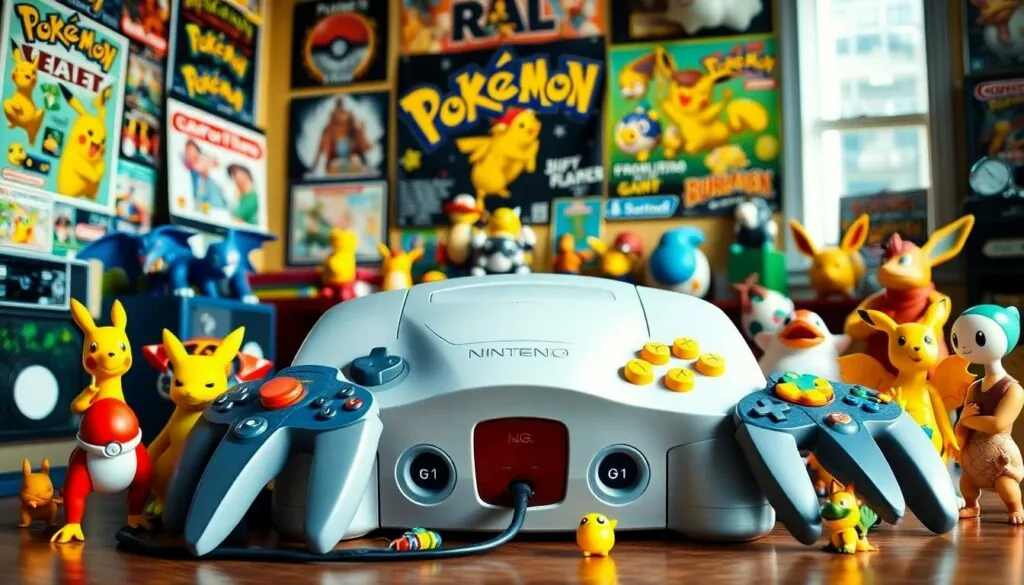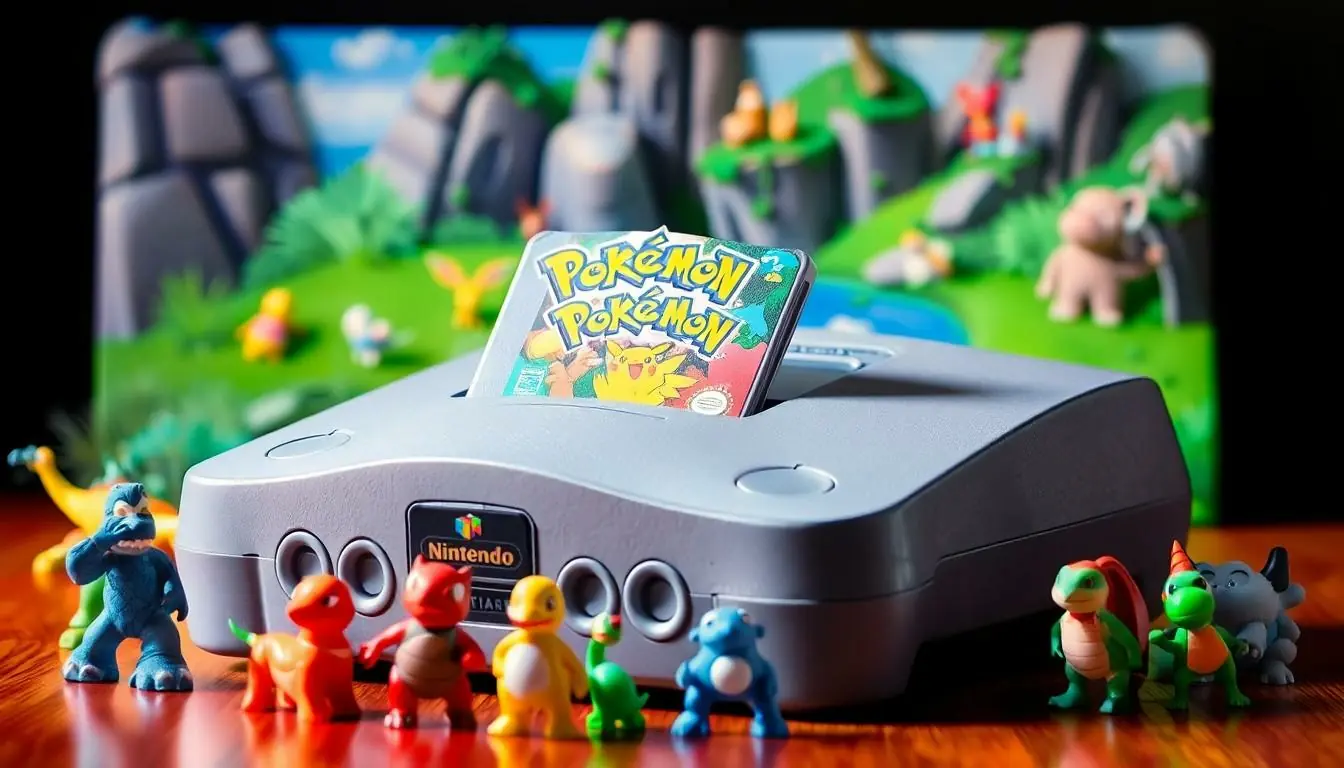In the magical realm of gaming nostalgia, few things spark joy like the sight of a Nintendo 64 and the iconic Pokémon franchise. Picture this: a time when 3D graphics were groundbreaking and catching ’em all felt like an epic quest rather than just a weekend hobby. The Nintendo 64 didn’t just bring Pokémon to life; it transformed the way fans experienced their favorite creatures, turning every battle and adventure into a vivid journey.
From the thrill of exploring lush landscapes to the unforgettable battles against friends, the Nintendo 64 was a playground for trainers. Whether it was mastering the art of throwing a Poké Ball or simply trying to figure out how to connect those pesky controllers, it was a wild ride. Join the adventure as we dive into the world where pixels and Pokémon collide, reigniting that childhood excitement one game at a time.
Table of Contents
ToggleOverview of Nintendo 64 Pokemon Games
Nintendo 64 provided an immersive gaming platform for Pokémon enthusiasts. Two standout titles, Pokémon Snap and Pokémon Stadium, showcased the capabilities of the console during its prime.
Pokémon Snap
Pokémon Snap revolutionized the way players interacted with Pokémon. Released in 1999, this photo safari game allowed players to take pictures of Pokémon in their natural habitats. The gameplay emphasized exploration, requiring creativity to capture the perfect shots. Players utilized a camera to snap photos of various Pokémon across diverse landscapes. Features like item usage and capturing Pokémon behaviors enhanced the experience. Unique scoring systems incentivized players to capture high-quality images. The game’s emphasis on photography created a distinct Pokémon experience not seen in other titles.
Pokémon Stadium
Pokémon Stadium transformed battles into a 3D spectacle. Released in 1998, this game allowed players to engage in Pokémon battles using their favorite Pokémon from the Game Boy titles. It featured a tournament mode, challenging players through progressively difficult matches. 3D graphics brought Pokémon to life, immersing players in a vibrant arena. A key aspect included the ability to battle against friends locally, fostering social interactions. The mini-games within provided varied gameplay, adding fun and competition. Players found enjoyment in accessing their Game Boy Pokémon, creating an engaging link between the two platforms.
Gameplay Mechanics
Nintendo 64 revolutionized gameplay mechanics within the Pokémon universe, particularly through graphics and multiplayer features.
Graphics and Sound
3D graphics showcased vibrant, immersive worlds in titles like Pokémon Snap and Pokémon Stadium. Players experienced lush environments filled with detailed Pokémon in their natural habitats. The sound design complemented the visuals, providing memorable music and sound effects that enhanced the gaming experience. Iconic battle music added excitement during competitive play. Overall, these elements combined to create a captivating atmosphere, drawing players into the adventure.
Multiplayer Features
Local multiplayer capabilities transformed gameplay by allowing players to battle friends and participate in tournaments. Pokémon Stadium featured head-to-head competitions while providing opportunities for cooperative play through mini-games. These interactive experiences invited social engagement among friends, heightening the overall enjoyment. Players could connect their Game Boy cartridges, enabling them to transfer Pokémon from handheld devices. This integration encouraged strategic planning and strengthened the link between the two platforms, making multiplayer an essential aspect of the Pokémon experience on Nintendo 64.
Impact on Gaming Culture
Nintendo 64’s influence on gaming culture remains significant in many ways. The mix of nostalgia and innovation established a strong foundation for future games.
Nostalgia and Legacy
Memories of Pokémon on the Nintendo 64 evoke strong emotions for many gamers. Playing titles like Pokémon Snap and Pokémon Stadium during childhood created lasting impressions. These experiences shaped a generation’s love for Pokémon and 3D gaming. The blend of vibrant graphics and engaging gameplay set new standards for future titles. As time passed, nostalgic remakes and sequels continued to reference these classic games. The legacy of Nintendo 64’s Pokémon titles influenced subsequent game designs and storytelling strategies. Fans often cite these games as essential parts of their gaming journeys.
Fan Community
The Pokémon fan community flourished alongside Nintendo 64’s release. Enthusiasts began to gather for tournaments and events, establishing a vibrant culture. Online forums and social media platforms became popular spaces for fans to share strategies, fan art, and experiences. Local multiplayer battles fueled competitive spirit, fostering friendships among players. The connection between Game Boy titles and Nintendo 64 encouraged discussions regarding gameplay strategies. Engaging with Pokémon in new ways solidified the community’s shared passion. This enduring enthusiasm for the games continues to inspire fan-created content and player-driven initiatives today.
Comparison with Other Pokémon Titles
Comparing Nintendo 64 Pokémon games to titles on other platforms reveals unique gameplay experiences. The Nintendo 64 introduced gameplay that differed significantly from Game Boy titles.
Game Boy Pokémon Games
Game Boy Pokémon games focused on 2D graphics and traditional role-playing mechanics. Players explored regions such as Kanto and Johto, capturing Pokémon and battling trainers. Pokémon Red and Blue set the foundation for strategy, offering trade capabilities and a complex type system. The experience was more linear compared to the expansive environments of the Nintendo 64. Players engaged with fewer interactive elements, but the emphasis on exploration and team building remained central. Fans appreciated the portability of Game Boy games, allowing playtime on the go. Despite the limitations of the hardware, these titles established a loyal fanbase that nurtured the franchise’s growth.
Pokémon Wii and Switch Games
Pokémon games on the Wii and Switch utilize advanced technology for a richer experience. Titles like Pokémon Battle Revolution and Pokémon Sword and Shield present enhanced graphics and more intricate gameplay mechanics. Engaging in 3D battles features dynamic animations and vibrant visuals. While Nintendo 64 titles emphasized local multiplayer, current games offer online connectivity, expanding competition globally. The incorporation of open-world elements makes exploration more immersive than ever. Players now navigate vast regions, capturing Pokémon and completing quests in intricate landscapes. Creativity shines through in Pokémon Let’s Go, which incorporates elements from the original Game Boy titles while embracing new gameplay features. These modern iterations showcase an evolution of gameplay that builds on Nintendo 64’s legacy.
Conclusion
The Nintendo 64’s contribution to the Pokémon franchise created a lasting impact that resonates with fans to this day. Its innovative 3D graphics and multiplayer capabilities transformed how players engaged with Pokémon, fostering unforgettable memories. Titles like Pokémon Snap and Pokémon Stadium not only showcased the console’s potential but also deepened the emotional connections many have with the series.
As the gaming landscape continues to evolve, the legacy of the Nintendo 64 remains a cornerstone of Pokémon history. It laid the groundwork for future innovations while nurturing a passionate community that thrives on shared experiences. The nostalgia and excitement generated by this era continue to inspire new generations of gamers, ensuring that the magic of Pokémon lives on.


